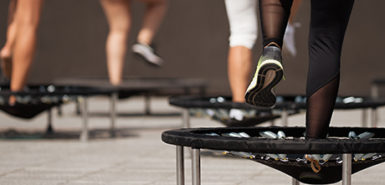
Cold temperatures and varying barometric pressures can usher in aches and pains.
But do people really “feel it in their bones,” or is it fallacy?
C. Christopher Sherry, DO, section chief for Spectrum Health Medical Group Adult Joint Reconstruction, said a recent study determined that 67% of people report increased pain with changes in temperature or barometric pressure.
“We don’t have a good explanation and can’t really prove that it’s happening,” Dr. Sherry said. “The theory is that a drop in barometric pressure can cause tissues, tendons and muscles to expand, which can cause pain, specifically in the joints. That’s a theory, but we don’t have any proof of that.”
Whether it’s weather or other factors causing pain, Dr. Sherry offers his top 10 tips to give your bones and joints the gift of health this winter.
1. Maintain your ideal body weight
Your primary care physician can help you determine your ideal body weight. It’s more important than you realize. Even a few extra pounds can stress your joints.
“Your knees and hips can feel four to five times the pressure of your body weight,” Dr. Sherry said. “Even a small amount of weight can make a difference—10 pounds of weight loss can be 40 or 50 pounds of relief off those joints.”
There’s a definite correlation between obesity and arthritis, Dr. Sherry noted.
“A lot of things we can’t modify, like genetics,” he said. “But there are a lot of things we can modify, like body weight.”
If patients are having trouble losing weight on their own, Dr. Sherry will send them to a Spectrum Health dietitian for assistance.
“There are bariatric surgery programs for patients who are really having difficulty or are having excessive weight issues,” he said. “The average patient needs to lose 20 or 30 pounds.”
2. Keep moving
While cold weather may limit outdoor activities, it’s important to maintain a regular exercise regimen.
“People sometimes blame the cold weather for their pain, but a lot of patients get a lot less active as the temperature gets cold,” Dr. Sherry said. “Find a way to stay active. Stretching muscles around affected joints can help reduce pressure and ultimately improve pain. We get a lot of complaints of increased pain as it gets colder. We just don’t want to get outside in Michigan in the winter.”
Exercise is conducive to weight loss and healthy joints and muscles.
“Maintain healthy muscle strength, which ultimately builds muscle to help support the joints and reduce stress on your joints,” Dr. Sherry said. “Maintain healthy exercise habits and build good strength in the body.”
3. Engage in winter sports
“A large percentage of patients do cross-country skiing,” Dr. Sherry said. “It’s a great cardio workout if you have the capability of doing that.”
Sports such as ice skating and downhill skiing may carry a greater risk of injury, so judge your physical ability accordingly.
“Always make sure you’re comfortable doing those things and make sure you’re capable before you go ski a black diamond hill,” Dr. Sherry said. “Especially as we get older, we want to ease into those sporting risks.”
4. Shovel sensibly
If you suffer from arthritis or joint pain, keep in mind shoveling is a strenuous activity, not only to your heart and lungs, but to your joints.
“Shoveling can put a lot of stress on the joints,” Dr. Sherry said. “Make sure you’re taking your time and not over-doing it. Take your time, pace yourself and shovel small amounts of snow at a time. It’s a lot less stress on the body. Don’t overload the shovel.”
5. Stick to low-impact exercise
Don’t launch into jumping jacks or jogging if you suffer from arthritis or joint pain. Instead, choose low-impact exercises such as water aerobics, swimming, walking, biking and elliptical machines.
“A lot of people do boot camp exercise classes,” Dr. Sherry said. “But sometimes they do a lot of high-impact moves and a lot of jumping in those classes. Try to modify if you’re going to do them and stay as low-impact as possible to reduce stress on the joints.”
6. Try natural supplements
Herbs and natural supplements such as fish oil, ginger, turmeric and ginkgo are natural remedies to reduce inflammation in the body. But, as always, check with your primary care physician before introducing anything new into your daily life.
7. Fight inflammation
Dr. Sherry said if you’re experiencing pain, anti-inflammatories such as ibuprofen or Aleve can help.
“But we always recommend contacting your primary care provider before starting anything,” he said. “Ice or heat on your affected joints can also be helpful. If you’re walking and have swelling in your knee, ice can help.”
8. Combat cold
Don’t let your winter wardrobe wane. It’s important to preserve body heat.
“Stay warm and stay bundled up if you’re going to be walking outside or shoveling snow,” Dr. Sherry said. “Keeping the body warm is helpful for patients.”
9. Stretch
Moving and stretching can ease joint pain.
“Stretch to maintain flexibility in the joints,” Dr. Sherry said. “Stiff joints can lead to increased stress in the joints which can lead to problems, pain and different disorders. The idea is to keep those joints flexible by keeping those joints moving. Keep a full range of motion to maximize function.”
10. Listen to your body
“I always tell my patients to listen to your body when you’re doing exercises or activities,” Dr. Sherry said. “The older mentality was to fight through it, no pain, no gain. If you’re doing these activities and are having pain, back off and modify it. Listen to what your joints are telling you. Limit stress and pain.”
 /a>
/a>
 /a>
/a>
 /a>
/a>
One more tip? Limit your sugar and highly processed foods to fight the inflammation within.
I was so surprised at your great help I have started low exercises eating less fats more veg soups now and added a heat blanket at night that you very much!! Continued on vit D hope my bones quit hurting now!!